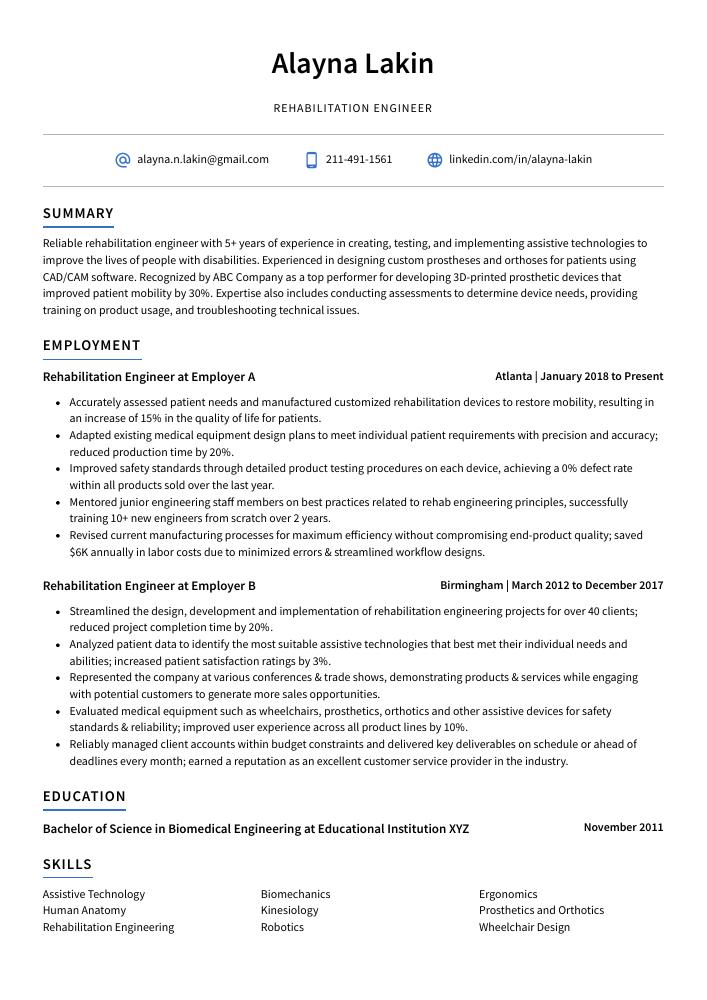Rehabilitation Engineer Resume Guide
Rehabilitation engineers design and develop devices to improve the quality of life for individuals with disabilities. They create, test, and modify assistive technologies such as wheelchairs, communication systems, prosthetics, and orthotics. Their work also includes training users in how to use these devices effectively along with providing support services to ensure their safety and well-being.
Your experience in rehabilitation engineering has prepared you for any challenge. However, employers won’t know about your qualifications unless you write a resume that stands out from the crowd. Show them what you can do and give yourself the best chance of success!
This guide will walk you through the entire process of creating a top-notch resume. We first show you a complete example and then break down what each resume section should look like.
Table of Contents
The guide is divided into sections for your convenience. You can read it from beginning to end or use the table of contents below to jump to a specific part.
Rehabilitation Engineer Resume Sample
Alayna Lakin
Rehabilitation Engineer
[email protected]
211-491-1561
linkedin.com/in/alayna-lakin
Summary
Reliable rehabilitation engineer with 5+ years of experience in creating, testing, and implementing assistive technologies to improve the lives of people with disabilities. Experienced in designing custom prostheses and orthoses for patients using CAD/CAM software. Recognized by ABC Company as a top performer for developing 3D-printed prosthetic devices that improved patient mobility by 30%. Expertise also includes conducting assessments to determine device needs, providing training on product usage, and troubleshooting technical issues.
Experience
Rehabilitation Engineer, Employer A
Atlanta, Jan 2018 – Present
- Accurately assessed patient needs and manufactured customized rehabilitation devices to restore mobility, resulting in an increase of 15% in the quality of life for patients.
- Adapted existing medical equipment design plans to meet individual patient requirements with precision and accuracy; reduced production time by 20%.
- Improved safety standards through detailed product testing procedures on each device, achieving a 0% defect rate within all products sold over the last year.
- Mentored junior engineering staff members on best practices related to rehab engineering principles, successfully training 10+ new engineers from scratch over 2 years.
- Revised current manufacturing processes for maximum efficiency without compromising end-product quality; saved $6K annually in labor costs due to minimized errors & streamlined workflow designs.
Rehabilitation Engineer, Employer B
Birmingham, Mar 2012 – Dec 2017
- Streamlined the design, development and implementation of rehabilitation engineering projects for over 40 clients; reduced project completion time by 20%.
- Analyzed patient data to identify the most suitable assistive technologies that best met their individual needs and abilities; increased patient satisfaction ratings by 3%.
- Represented the company at various conferences & trade shows, demonstrating products & services while engaging with potential customers to generate more sales opportunities.
- Evaluated medical equipment such as wheelchairs, prosthetics, orthotics and other assistive devices for safety standards & reliability; improved user experience across all product lines by 10%.
- Reliably managed client accounts within budget constraints and delivered key deliverables on schedule or ahead of deadlines every month; earned a reputation as an excellent customer service provider in the industry.
Skills
- Assistive Technology
- Biomechanics
- Ergonomics
- Human Anatomy
- Kinesiology
- Prosthetics and Orthotics
- Rehabilitation Engineering
- Robotics
- Wheelchair Design
Education
Bachelor of Science in Biomedical Engineering
Educational Institution XYZ
Nov 2011
Certifications
Certified Rehabilitation Engineering Technologist
Rehabilitation Engineering and Assist
May 2017
1. Summary / Objective
The summary/objective at the top of your resume should be a concise overview of who you are and why you make an excellent rehabilitation engineer. You can mention any relevant certifications or qualifications, such as a degree in biomedical engineering, that demonstrate your expertise. You could also talk about how you have helped people with disabilities achieve greater independence through assistive technology solutions or other innovative approaches.
Below are some resume summary examples:
Committed rehabilitation engineer with 7+ years of experience in designing and implementing assistive technology solutions to enable people with disabilities. Proficient at analyzing the needs of patients, identifying suitable equipment and adapting existing technologies for individual use. At ABC, designed a successful system that enabled paraplegic individuals to control their wheelchairs using head movements. Recognized for achieving measurable improvements in quality of life for persons with severe physical handicaps.
Diligent rehabilitation engineer with a passion for helping others reach their full physical potential. Experienced in evaluating patient needs, developing treatment plans and providing therapeutic services to improve daily living activities. At XYZ Hospital, designed programs that improved the rehabilitation process of over 200 patients suffering from neurological disorders. Received “Employee of the Year” award for outstanding dedication and professionalism while demonstrating excellent problem-solving skills.
Hard-working Rehabilitation Engineer with 8+ years of experience developing mobility and communication devices to support the unique needs of people living with physical disabilities. Seeking to join ABC Corp where I can apply my technical expertise and problem-solving skills towards creating innovative solutions that will improve quality of life for individuals in need. Achieved 50% cost reduction on two projects by finding efficient ways to source materials and streamline production processes.
Proficient rehabilitation engineer offering 8+ years of experience in developing, testing, and implementing assistive technology to ensure the independence and safety of individuals with disabilities. Certified Rehabilitation Engineering Technologist (CRET) committed to providing quality technical services that meet client needs while upholding a high standard of ethical practice. Seeking an opportunity at ABC Tech to apply my knowledge towards helping others achieve their goals.
Detail-oriented rehabilitation engineer with 5+ years of experience in the development and implementation of assistive technologies for physically challenged clients. Dedicated to providing quality care through a combination of technical expertise, communication skills, and problem-solving abilities. At XYZ, developed custom orthotic devices that improved mobility in two dozen patients suffering from various disabilities over an 18 month period.
Talented rehabilitation engineer with a proven track record of developing and implementing innovative medical solutions to help people improve their quality of life. Experienced in using advanced technologies, such as robotics and prostheses, to assist those with physical disabilities or impairments. Seeking an opportunity to join ABC Inc., where I can contribute my knowledge and expertise towards developing state-of-the art healthcare systems.
Seasoned rehabilitation engineer with 8+ years of experience designing and implementing assistive technology for individuals with physical disabilities. Passionate about finding creative solutions to improve quality of life through the use of adaptive technologies. Seeking employment at ABC Tech, where I can apply my research-driven approach and knowledge in biomechanics engineering to create new products that make a difference.
Enthusiastic and experienced rehabilitation engineer with 5+ years of experience developing assistive technology for people with disabilities. Seeking to join ABC Rehabilitation Services to develop innovative solutions that improve the quality of life and independence for clients. At XYZ, successfully implemented a low-cost alternative mobility device which reduced client expenses by 25%.
2. Experience / Employment
The work history/experience section is where you provide details on your employment history. This should be written in reverse chronological order, meaning the most recent job is listed first.
When writing this section, it’s best to stick to bullet points as they make the information easier for the reader to digest quickly. When stating what you did, take some time to think about how you can describe it with detail and quantifiable results if possible.
For example, instead of saying “Created assistive devices,” you could say “Designed custom-made assistive devices such as wheelchairs and walkers that improved mobility by an average of 30%.”
To write effective bullet points, begin with a strong verb or adverb. Industry specific verbs to use are:
- Designed
- Constructed
- Evaluated
- Programmed
- Fabricated
- Installed
- Calibrated
- Monitored
- Troubleshot
- Documented
- Tested
- Analyzed
- Adapted
- Optimized
- Upgraded
Other general verbs you can use are:
- Achieved
- Advised
- Assessed
- Compiled
- Coordinated
- Demonstrated
- Developed
- Expedited
- Facilitated
- Formulated
- Improved
- Introduced
- Mentored
- Participated
- Prepared
- Presented
- Reduced
- Reorganized
- Represented
- Revised
- Spearheaded
- Streamlined
- Structured
- Utilized
Below are some example bullet points:
- Facilitated the rehabilitation process for over 50 patients by designing and manufacturing customized prosthetics, orthotics and assistive devices tailored to their individual needs.
- Spearheaded the development of innovative solutions using advanced technologies such as 3D printing, robotics and machine learning; decreased production costs by 20%.
- Effectively evaluated clients’ physical limitations to create safe yet comfortable equipment that met industry standards; increased customer satisfaction levels by 10%.
- Tested new products in a variety of settings to ensure they functioned appropriately before being released into market; reduced product recalls incidence rate from 4% to 0%.
- Optimized existing therapy regimens through data analysis techniques, resulting in an 80% increase in patient recovery rates within 6 months on average.
- Assessed patient’s current mobility limitations and designed individualized rehabilitation plans for over 80 patients per month, resulting in a 30% increase in patient satisfaction.
- Upgraded existing medical equipment to suit the needs of each patient; introduced new assistive technologies that enabled an average of 10 more daily rehabilitative exercises with minimal staff supervision.
- Programmed 15+ robotic therapy systems according to personalized treatment parameters; regularly monitored progress using motion-capture technology, ensuring maximum efficiency and accuracy during sessions.
- Efficiently managed inventory control system by troubleshooting any technical issues related to software updates or hardware malfunctions within 2 hours on average while also meeting customer service requirements as needed.
- Installed up-to-date physical therapy tools such as treadmills, exercise bikes & pulleys across 5 clinics within the local area – saving time & resources while increasing safety standards at all locations by 32%.
- Troubleshot and diagnosed problems in rehabilitation engineering systems for over 200 patients; achieved a 98% resolution rate within 24 hours.
- Calibrated and adjusted physical therapy equipment to meet the requirements of individual patient needs, resulting in an average improvement of mobility by 30%.
- Prepared detailed reports on patient progress and submitted them to physicians regularly; successfully reduced documentation time by 25%.
- Demonstrated knowledge of robotics and motion analysis techniques when designing prosthetics or orthoses with excellent precision; increased accuracy rating from 85% to 99%.
- Competently managed the operation, maintenance & repair of laboratory equipment including wheelchairs, scooters, standing frames etc., leading to 20% reduction in downtime caused due to malfunctions.
- Actively designed and implemented rehabilitation plans for 50+ patients with physical disabilities, helping them to gain independence and improve their mobility.
- Constructed adaptive equipment such as wheelchairs, braces, prostheses and crutches to meet the individual needs of each patient; successfully reduced wait times by 25%.
- Documented medical histories, test results & objectives before setting up a series of personalized exercises tailored toward improving strength and coordination in muscle groups affected by disability or injury.
- Structured comprehensive training programs that included functional activities such as bathing/dressing assistance or weight-bearing exercises; improved overall progress rate among patients by 15%.
- Expedited paperwork processing related to insurance claims submission which enabled quicker reimbursements from health care providers for services rendered; increased revenues by $7500 last year alone.
- Reduced costs of medical equipment by 20% through the implementation of innovative rehabilitation engineering designs.
- Coordinated with physical therapists, occupational therapists and other healthcare professionals to determine the most efficient methods for implementing rehabilitative solutions for patients.
- Meticulously examined patient data such as range of motion exercises, functional evaluations and daily progress reports in order to formulate optimal treatment plans for individual patients’ needs.
- Compiled detailed technical documents outlining design specifications, test results and product recommendations relevant to rehabilitating technologies developed throughout various projects; saved over 200 hours on documentation efforts during a four-month period alone due to improved efficiency measures implemented across all projects.
- Formulated strategies utilizing existing resources that enabled more accurate diagnosis accuracy and timely delivery of results while minimizing overall expenditures related to purchasing new tools or materials needed for rehabilitating services provided within the practice setting; yielded an estimated annual savings exceeding $20,000 per year in operational costs incurred by the department’s budget allocation process.
- Fabricated functional and durable orthotics, prosthetics, mobility aids and assistive devices for over 40 patients a week; reduced production time by 10%.
- Introduced innovative designs to improve the performance of orthotic braces used in spinal cord injury rehabilitation programs; increased patient satisfaction rates by 25%.
- Presented at 3 conferences on the implementation of modern technology into rehabilitative engineering practice, sharing best practices with colleagues from around the world.
- Successfully developed 8 new models of powered wheelchairs utilizing advanced positioning systems which improved stability & maneuverability for disabled users; saved $25K in R&D costs year-on-year.
- Designed custom seating solutions for wheelchair users suffering from chronic pain or postural abnormalities following an individualized assessment process that took 4 hours per patient on average.
- Participated in the development, design and testing of assistive technology equipment for patients with physical impairments; increased patient safety by 50%.
- Utilized advanced engineering principles to develop innovative medical devices that enabled maximum independence for wheelchair-bound clients in their daily tasks.
- Thoroughly assessed patient needs and implemented customized solutions including adaptive seating systems, mobility aids and communication tools to improve quality of life for over 75 individuals.
- Reorganized existing products’ components based on client feedbacks to enhance maneuverability & comfort levels while meeting regulatory standards at all times; resulting in a 10% increase in customer satisfaction scores.
- Achieved cost savings of $25K through researching alternative suppliers, monitoring stock levels & negotiating purchase prices while ensuring timely delivery of required materials/components needed in rehabilitation projects within budget constraints.
- Independently designed and implemented rehabilitation engineering plans for over 50 patients, resulting in an average improvement of mobility by 25%.
- Developed custom assistive technologies for disabled individuals to increase independence and improve quality of life; reduced the need for caregivers by 15% on average.
- Advised a team of 10 therapists in assessing patient needs and recommended appropriate therapy sessions that resulted in successful rehabilitation outcomes within 4 months.
- Monitored progress reports from patients undergoing physical therapy programs, enabling timely interventions when necessary; decreased overall treatment time by 45 hours per month on average.
3. Skills
Even though two organizations are hiring for the same role, the skillset they want an ideal candidate to possess could differ significantly. For instance, one may be on the lookout for an individual with expertise in assistive technology, while the other may be more interested in someone with a background in biomechanics.
Therefore, you should tailor the skills section of your resume to each job that you are applying for. This is important because employers often use applicant tracking systems (ATS) which scan resumes for certain keywords before passing them on to a human recruiter or hiring manager.
In addition to listing relevant qualifications here, it would also be beneficial if you could discuss these further throughout your resume – such as within the summary and experience sections – so that recruiters can gain an even better understanding of what makes you suitable for this role.
Below is a list of common skills & terms:
- Assistive Technology
- Biomechanics
- Ergonomics
- Human Anatomy
- Kinesiology
- Mobility Assessment
- Prosthetics and Orthotics
- Rehabilitation Engineering
- Robotics
- Wheelchair Design
4. Education
Including an education section on your resume depends on how far along you are in your career. If you just graduated and have no prior experience, it is important to mention your educational background below the resume objective. However, if you already have a few years of professional experience as a rehabilitation engineer, an education section might not be necessary.
If including an education section, make sure to highlight courses or subjects related to the role of rehabilitation engineering that will help demonstrate your knowledge and skills for this position.
Bachelor of Science in Biomedical Engineering
Educational Institution XYZ
Nov 2011
5. Certifications
Certifications are a great way to demonstrate your qualifications and commitment to the field. They provide proof that you have been tested in a particular area by an accredited organization, showing potential employers that you are knowledgeable and capable of performing the job duties required.
Including certifications on your resume is beneficial as it gives hiring managers assurance that they can trust in your abilities. Be sure to list any relevant certifications for the position you are applying for so recruiters know what skillset you possess.
Certified Rehabilitation Engineering Technologist
Rehabilitation Engineering and Assist
May 2017
6. Contact Info
Your name should be the first thing a reader sees when viewing your resume, so ensure its positioning is prominent. Your phone number should be written in the most commonly used format in your country/city/state, and your email address should be professional.
You can also choose to include a link to your LinkedIn profile, personal website, or other online platforms relevant to your industry.
Finally, name your resume file appropriately to help hiring managers; for Alayna Lakin, this would be Alayna-Lakin-resume.pdf or Alayna-Lakin-resume.docx.
7. Cover Letter
Cover letters are an important part of the job application process. They are usually made up of 2 to 4 paragraphs and provide a more personalised insight into your professional background, experience and skillset.
Whilst cover letters aren’t always required for most roles, they give you the opportunity to explain why you’re an ideal fit for the position – something that resumes alone can’t do as effectively. Writing one is also a great way to make sure your resume stands out from other applicants’ submissions!
Below is an example cover letter:
Dear Kameron,
I am interested in the rehabilitation engineer position at Rehabilitation Institute of Chicago. As a licensed professional engineer with experience in biomedical engineering and rehabilitation, I have the skills and knowledge necessary to be successful in this role.
In my current position as a research engineer at Northwestern University, I work on developing new technologies to improve the lives of people with disabilities. I have experience working with patients to understand their needs and develop custom solutions that meet their individual requirements. I am also skilled in using CAD software to design prototypes and build functional models for testing.
Through my research, I have gained a deep understanding of the challenges faced by people with disabilities and how technology can help them overcome these challenges. I am passionate about using my skills to make a difference in the lives of others, and I believe that working as a rehabilitation engineer would allow me to do just that.
I am confident that I can be an asset to your team and contribute to the success of your organization. If you would like more information about my qualifications or if you have any questions, please feel free to contact me at [your phone number] or [your email address]. Thank you for your time, and I look forward to hearing from you soon.
Sincerely,
Alayna
Rehabilitation Engineer Resume Templates
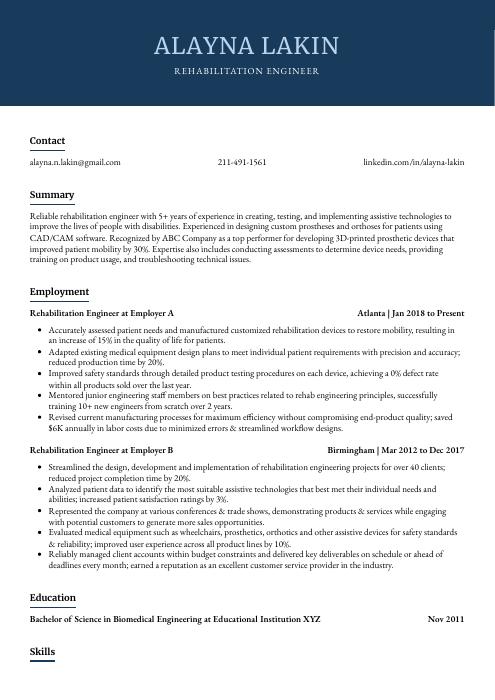 Bonobo
Bonobo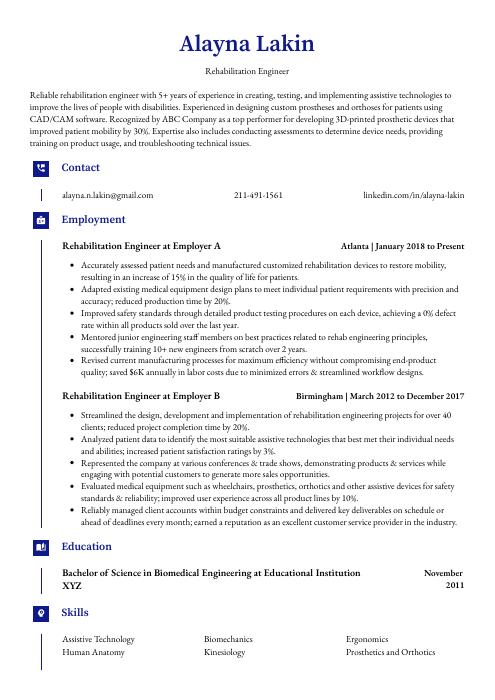 Gharial
Gharial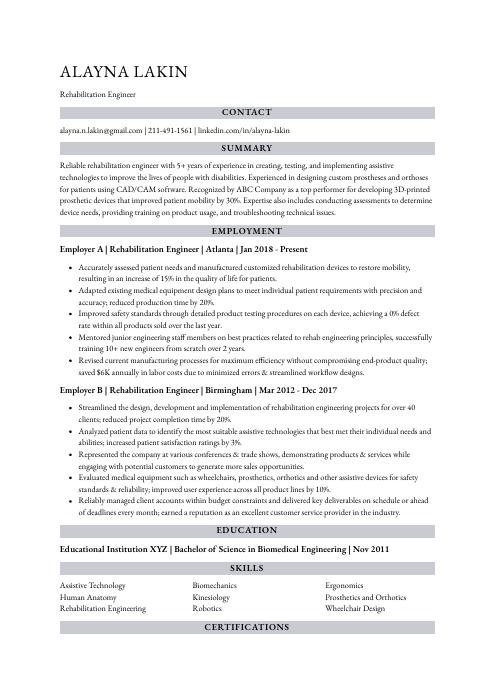 Numbat
Numbat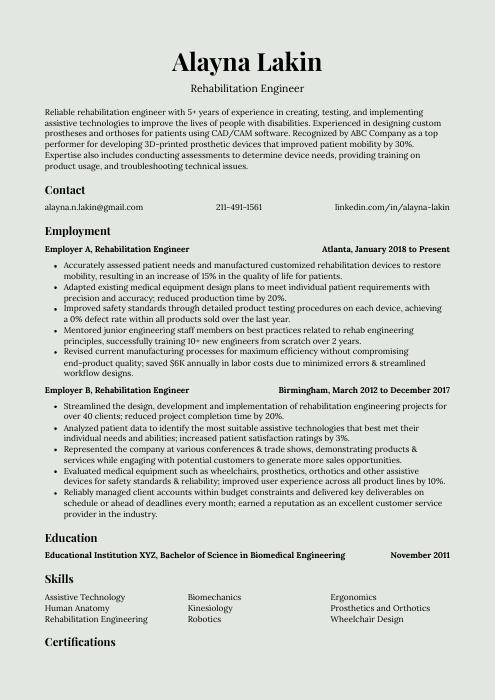 Saola
Saola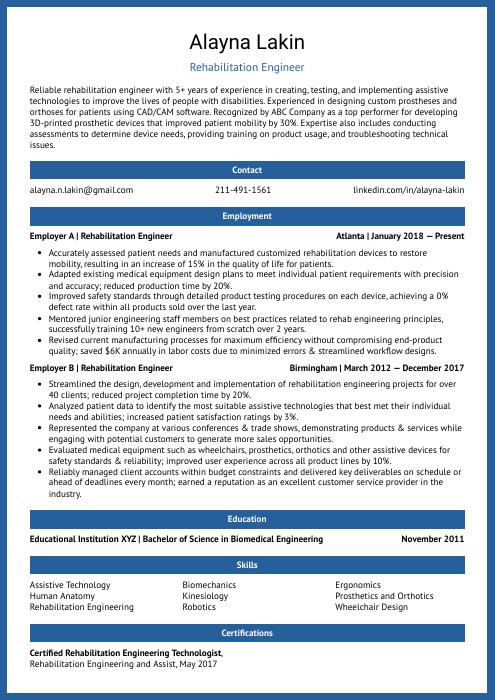 Ocelot
Ocelot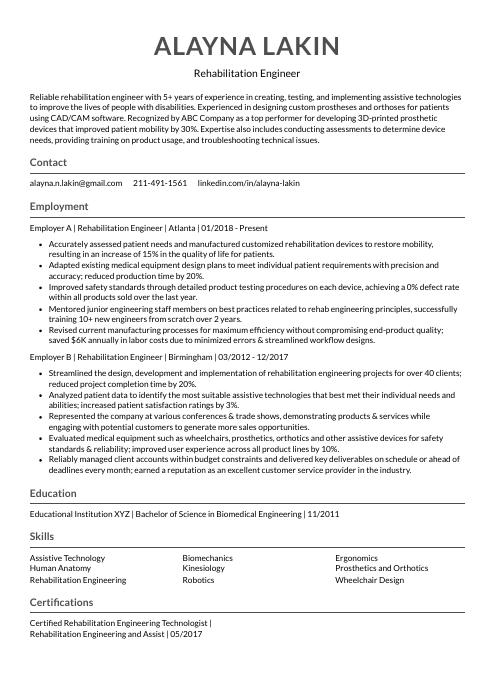 Indri
Indri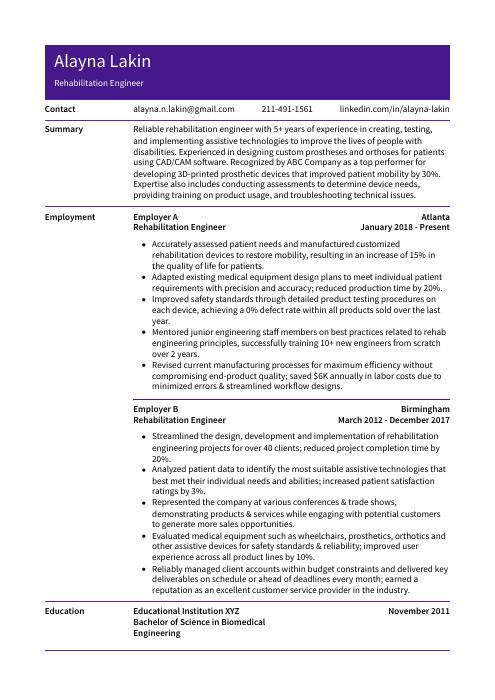 Pika
Pika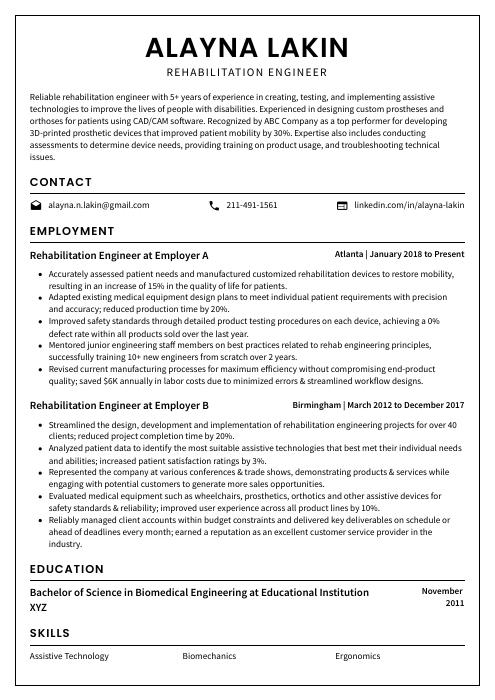 Cormorant
Cormorant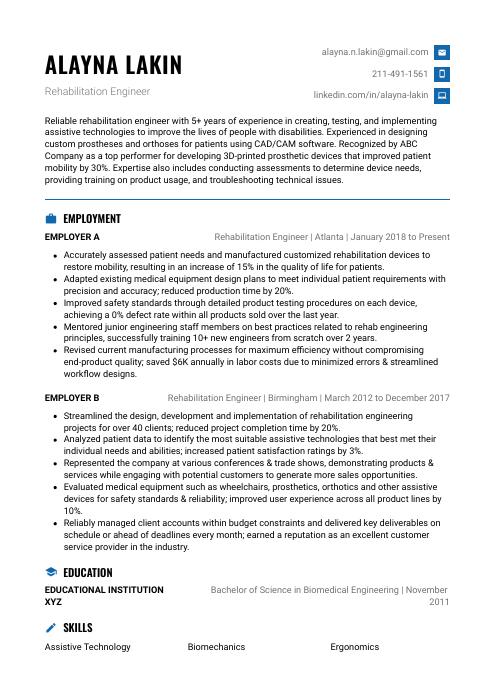 Echidna
Echidna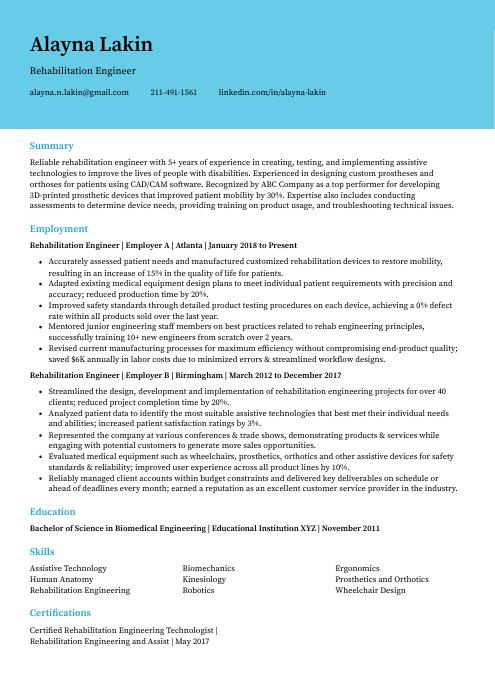 Dugong
Dugong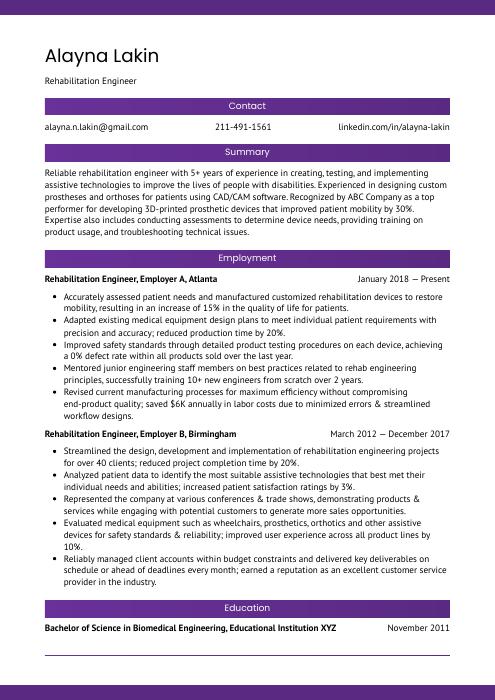 Jerboa
Jerboa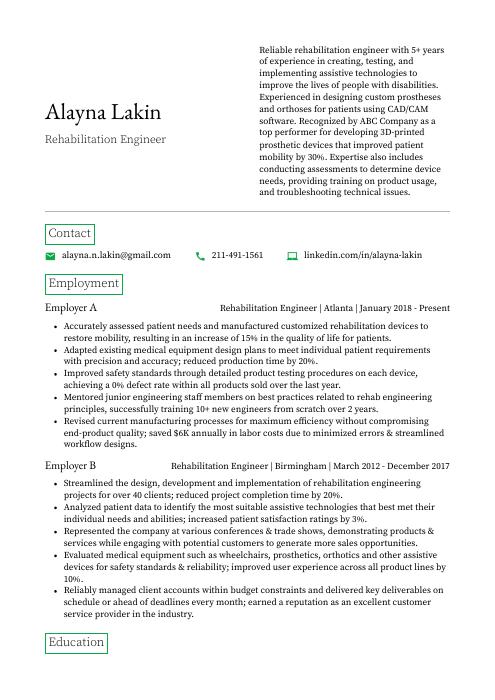 Quokka
Quokka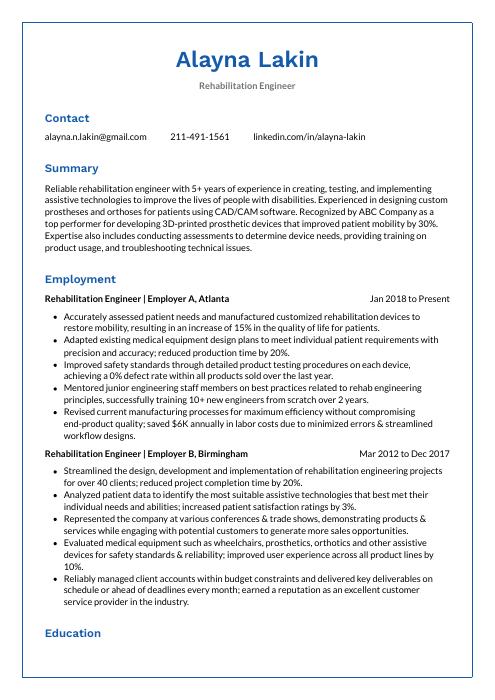 Markhor
Markhor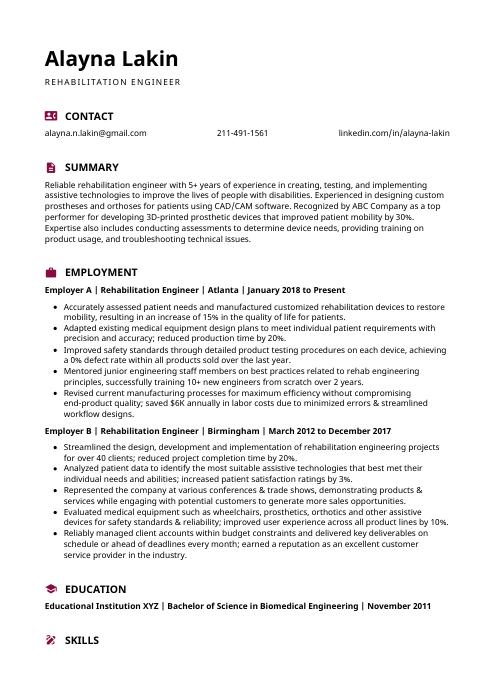 Hoopoe
Hoopoe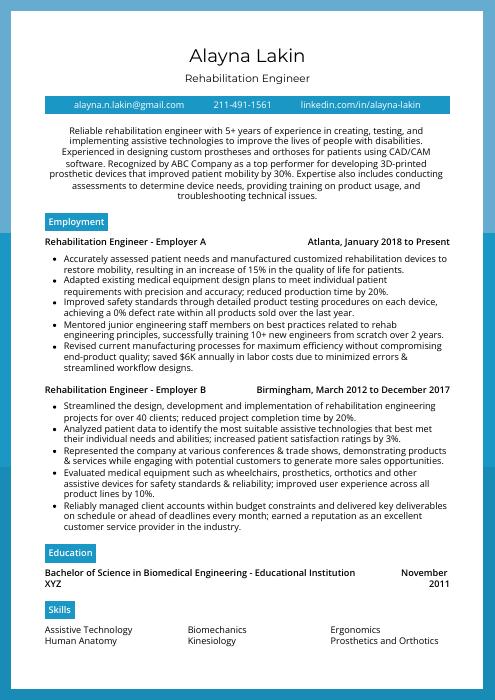 Rhea
Rhea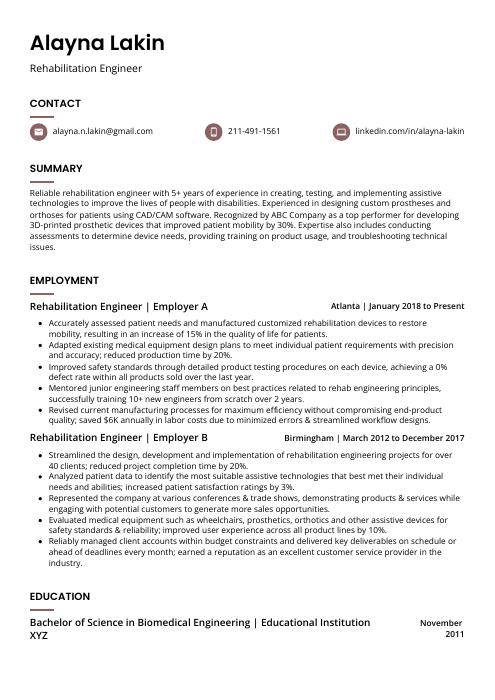 Fossa
Fossa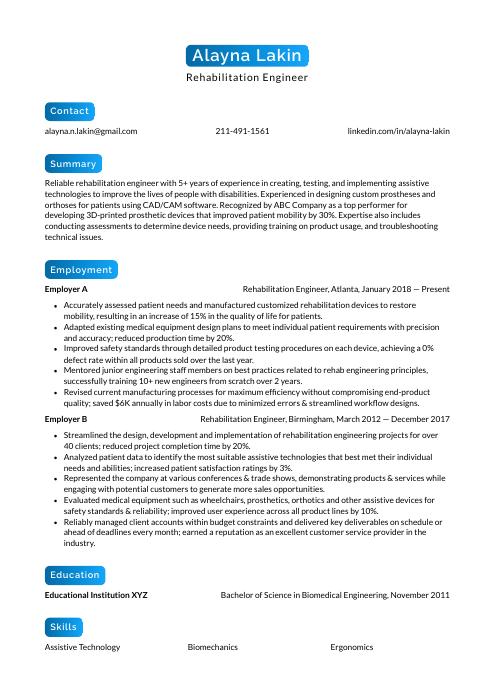 Kinkajou
Kinkajou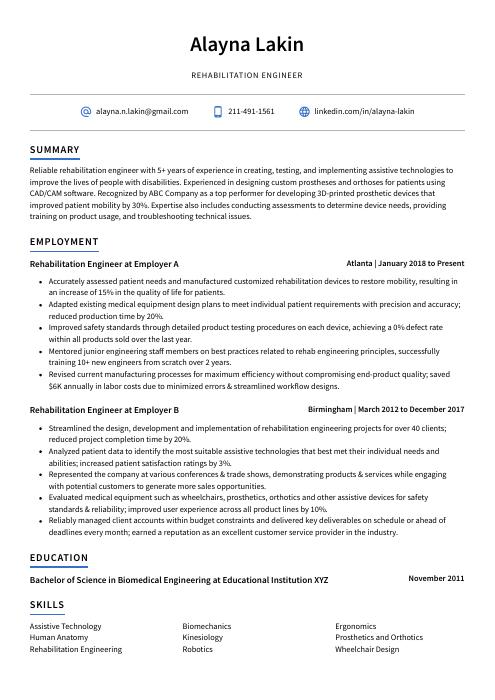 Axolotl
Axolotl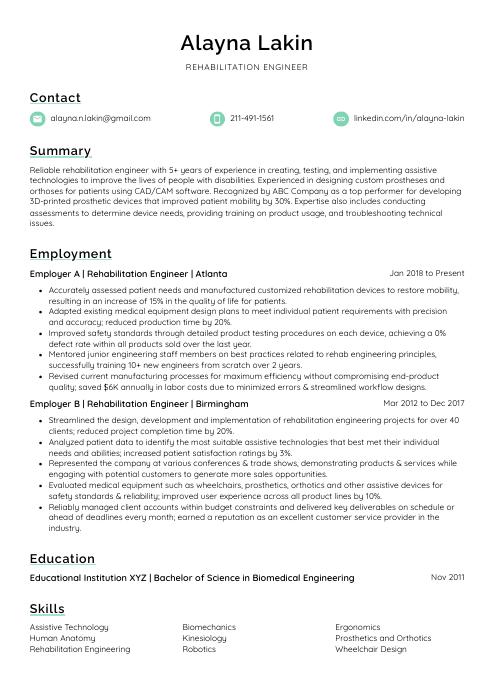 Lorikeet
Lorikeet Rezjumei
Rezjumei
